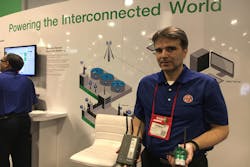Leveraging IIoT to monitor water and wastewater applications
Recently, I had the pleasure of attending the Electrical Apparatus Service Association (EASA) annual convention in Tampa, Florida. Themed “Partners for Progress,” the event was attended by EASA members, end users, manufacturers and service providers who engaged wholeheartedly in a full schedule of educational presentations, exhibits and networking sessions.
One of the hot-button topics covered at EASA 2017, as it is at most conferences these days, was the Industrial Internet of Things (IIoT). Chris Wiseman of Nidec Motor Company presented a session at the show, titled “The Industrial Internet of Things: What Does It Mean to You?,” during which he cited a forecast that predicted the number of B2B IoT connections to increase to 5.4 billion by 2020.
The sensors can easily clip onto a piece of rotating equipment, and the price point for the hardware is less than $1,000 with a monthly subscription fee for the monitoring interface. It is IIoT on an entry level budget, and water and wastewater systems are a perfect fit for this sort of practical application.
Wiseman mentioned industry is currently in the middle of an IoT evolution, where the focus is shifting from connections to actions. “It used to be a big deal to be connected, but going forward, being connected is a given,” said Wiseman. “How can we put the intelligence into the data that is being collected?”
Following Wiseman’s presentation, I ventured over to the Nidec booth on the show floor to see how the company brings its take on IIoT to the real world. During my tour, Nidec’s Thomas Schardt made an interesting point: Water and wastewater applications are, in many ways, ideal proving grounds for IIoT systems. He explained that traditionally water and wastewater applications have not been heavily monitored, primarily because the cost of installing and connecting sensors for such systems was perceived as outweighing the potential benefit.
However, as sensor costs continue to fall and the simplicity and accessibility of IIoT continues to rise, monitoring water and wastewater applications is now possible and can, in many cases, minimize the cost of unplanned downtime. So, rather than running to failure, as many water and wastewater systems have typically operated, these systems can now leverage sensors to monitor and gain intelligence on system performance, troubleshoot problem areas, and prevent failures before they happen.
For example, Nidec’s FORECYTE system leverages a stand-alone remote monitoring platform that uses battery-powered wireless sensors to measure and report equipment vibration and temperature on rotating equipment. The sensors can easily clip onto a piece of rotating equipment, and the price point for the hardware is less than $1,000 with a monthly subscription fee for the monitoring interface. It is IIoT on an entry level budget, and water and wastewater systems are a perfect fit for this sort of practical application.
For my full report on the goings on at EASA 2017, read my “5 key takeways from EASA 2017.”
Matt Migliore is director of content strategy for the Process Flow Network. He has covered technology and industry for 15 years. He can be reached at [email protected] or 484-255-9032.
